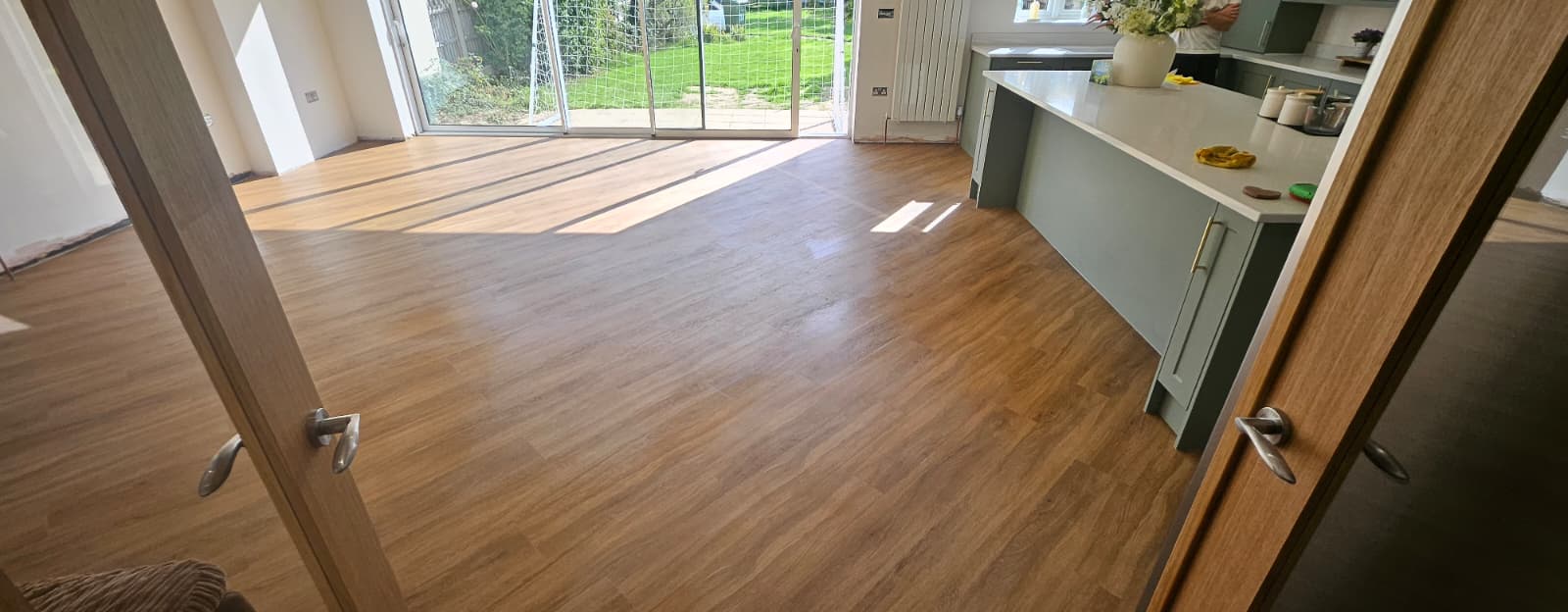If you’ve been researching flooring options lately, you’ve probably come across the term LVT quite a few times. Short for Luxury Vinyl Tile, LVT has become one of the most popular modern flooring choices for homes, offices, schools, and commercial spaces. But what exactly is LVT flooring, and why has it gained such widespread popularity?
This guide breaks it all down — what LVT is made of, how it’s installed, its advantages and limitations, and where it works best. Whether you’re a homeowner, landlord, or commercial property manager, understanding the basics of LVT flooring can help you make a smarter long-term decision for your floors.
What Exactly Is LVT Flooring?
LVT, or Luxury Vinyl Tile, is a type of resilient flooring that mimics the look and texture of natural materials like wood, stone, or ceramic, but with added durability and ease of maintenance.
Unlike standard vinyl sheet flooring, LVT comes in individual tiles or planks, allowing for more realistic patterns and designs. It’s engineered in layers, typically consisting of:
- A wear layer – This is the transparent top layer that protects the surface from scratches, stains, and scuffs. The thickness of this layer often determines the floor’s durability.
- A design layer – A high-definition printed film that gives LVT its realistic wood, stone, or tile appearance.
- A core layer – Usually made of PVC or a rigid composite, this provides structure, stability, and strength.
- A backing layer – Offers extra support, comfort underfoot, and in some products, sound insulation.
Each layer plays an important role in creating a flooring product that looks great, lasts for years, and can handle the demands of busy households or commercial spaces.
How Is LVT Different from Other Types of Flooring?
At first glance, LVT might look similar to laminate flooring or even engineered wood, but there are key differences in both construction and performance.
- Compared to Laminate:
LVT is made from vinyl, which makes it water-resistant or even waterproof, while laminate is made with a wood-based core that can swell or warp if exposed to moisture. This makes LVT ideal for kitchens, bathrooms, and basements where spills and humidity are common.
- Compared to Sheet Vinyl:
Traditional sheet vinyl comes in large rolls, which can be harder to install or repair. LVT, on the other hand, comes in tiles or planks that are easier to fit, replace, or pattern individually.
- Compared to Real Wood or Stone:
LVT gives the appearance and texture of natural materials at a fraction of the cost and maintenance effort. It won’t need sanding, sealing, or refinishing — and it’s generally much warmer and quieter underfoot.
Types of LVT Installation
One of the biggest reasons LVT has become so popular is its flexible installation options. Depending on the type and setting, it can be fitted in several ways:
- Glue-Down LVT
This method involves using adhesive to bond each tile or plank directly to the subfloor. It’s very stable and ideal for commercial areas or high-traffic environments where durability is key.
- Click LVT (Floating Floor)
These planks or tiles simply click together over an underlay, without glue. It’s a cleaner and faster installation process that’s perfect for residential spaces or smaller jobs. Click systems can also be removed and replaced easily if needed.
- Loose Lay LVT
This version uses friction and weight to stay in place — no glue or locking mechanism. It’s particularly useful for temporary installations or spaces where quick access to the subfloor is required.
At Floors2U, we see all three types being used across different settings, depending on the size, use, and performance requirements of the project.
Where Can You Use LVT Flooring?
LVT is one of the most versatile flooring options available today. It’s suitable for both domestic and commercial environments, including:
- Homes: Living rooms, kitchens, hallways, bathrooms, and bedrooms.
- Offices: High-traffic corridors and workspaces that need to balance aesthetics with durability.
- Retail spaces: Where easy cleaning and wear resistance are crucial.
- Healthcare and education: LVT meets hygiene standards and can withstand heavy footfall.
- Rental properties: Landlords appreciate the low maintenance and long lifespan.
Its adaptability makes it a favourite for anyone who wants a professional finish that performs well across all kinds of conditions.
Advantages of LVT Flooring
Here are the main benefits that have made LVT a modern flooring staple:
- Durability – With its protective wear layer, LVT stands up well to scratches, dents, and stains.
- Water Resistance – Many LVT products are fully waterproof, making them safe for wet areas.
- Realistic Designs – Advances in printing technology mean you can achieve incredibly authentic wood or stone looks.
- Comfort and Warmth – Softer underfoot than tile or stone, LVT also works well with underfloor heating.
- Low Maintenance – Cleaning usually just requires sweeping and an occasional mop with a gentle cleaner.
- Affordability – Offers a premium look without the premium price of hardwood or stone.
- Ease of Repair – If one tile or plank gets damaged, it can be replaced individually.
Are There Any Downsides?
While LVT is highly versatile, there are still a few considerations:
- Subfloor preparation is essential — an uneven or damp subfloor can affect performance.
- Heavy furniture may cause indentations if floor protectors aren’t used.
- Direct sunlight over time can fade the design layer in areas with no UV protection.
However, these issues are manageable with proper installation and care — and compared to most other flooring types, LVT’s advantages far outweigh the drawbacks.
The Future of LVT Flooring
LVT technology is advancing rapidly. Modern designs include textured finishes that feel like real wood grain or stone surfaces, acoustic layers that reduce sound, and even eco-friendly options made from recycled materials. It’s clear that LVT is not just a passing trend — it’s a long-term evolution in flooring.
Final Thoughts
So, what is LVT flooring? In short, it’s one of the most practical, durable, and visually appealing flooring options available today. Its mix of resilience, water resistance, and design versatility makes it suitable for nearly any environment — from homes to hospitals.
If you’re planning a new flooring project, understanding what LVT offers helps you make an informed choice that balances appearance, budget, and performance. Whether you’re fitting out a rental property, upgrading your kitchen, or managing a commercial refurbishment, LVT remains one of the smartest, most reliable flooring solutions on the market.



